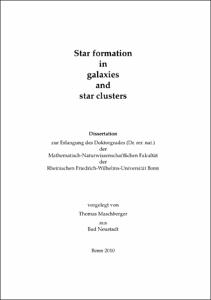Maschberger, Thomas: Star formation in galaxies and star clusters. - Bonn, 2011. - Dissertation, Rheinische Friedrich-Wilhelms-Universität Bonn.
Online-Ausgabe in bonndoc: https://nbn-resolving.org/urn:nbn:de:hbz:5N-24620
Online-Ausgabe in bonndoc: https://nbn-resolving.org/urn:nbn:de:hbz:5N-24620
@phdthesis{handle:20.500.11811/4954,
urn: https://nbn-resolving.org/urn:nbn:de:hbz:5N-24620,
author = {{Thomas Maschberger}},
title = {Star formation in galaxies and star clusters},
school = {Rheinische Friedrich-Wilhelms-Universität Bonn},
year = 2011,
month = jul,
note = {This thesis is devoted to star formation from galaxy-scales (approx. 10 000 pc) to sub-star cluster-scales (approx. 0.1 pc). I develop and test a new method to derive star formation histories of Galaxies from their star cluster content, in particular the most massive star clusters. This is followed by an application of this method to the Large Magellanic Cloud, where the results of this new method are confirmed with results obtained from counting individual stars. Stars form in a grouped way, in the basic unit of a star cluster, so that both the mass function of stars formed within a star cluster and the mass function of star clusters in a galaxy need to be known for a quantitative description of galaxy-wide star formation. These mass functions have a power-law functional form, for which I develop statistical tools to estimate the parameters and to perform goodness-of-fit tests, with a particular emphasis on the upper mass end. The statistical methods are applied to the star clusters in M51 to investigate the shape of the initial star cluster mass function and the early evolution of it. I also investigate the upper mass end of the stellar initial mass function, both in observations and theory. The analysis of a numerical simulation of star cluster formation (time-evolution of substructure, mass segregation, stellar mass function) concludes this thesis.},
url = {https://hdl.handle.net/20.500.11811/4954}
}
urn: https://nbn-resolving.org/urn:nbn:de:hbz:5N-24620,
author = {{Thomas Maschberger}},
title = {Star formation in galaxies and star clusters},
school = {Rheinische Friedrich-Wilhelms-Universität Bonn},
year = 2011,
month = jul,
note = {This thesis is devoted to star formation from galaxy-scales (approx. 10 000 pc) to sub-star cluster-scales (approx. 0.1 pc). I develop and test a new method to derive star formation histories of Galaxies from their star cluster content, in particular the most massive star clusters. This is followed by an application of this method to the Large Magellanic Cloud, where the results of this new method are confirmed with results obtained from counting individual stars. Stars form in a grouped way, in the basic unit of a star cluster, so that both the mass function of stars formed within a star cluster and the mass function of star clusters in a galaxy need to be known for a quantitative description of galaxy-wide star formation. These mass functions have a power-law functional form, for which I develop statistical tools to estimate the parameters and to perform goodness-of-fit tests, with a particular emphasis on the upper mass end. The statistical methods are applied to the star clusters in M51 to investigate the shape of the initial star cluster mass function and the early evolution of it. I also investigate the upper mass end of the stellar initial mass function, both in observations and theory. The analysis of a numerical simulation of star cluster formation (time-evolution of substructure, mass segregation, stellar mass function) concludes this thesis.},
url = {https://hdl.handle.net/20.500.11811/4954}
}






